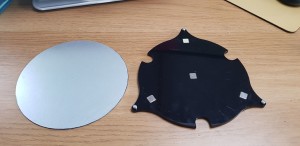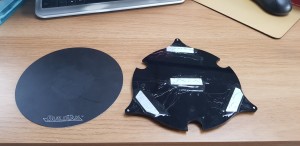Inspired by Jo Prusa’s flexible printing bed that attached to his machines magnetically, we decided to do the same for our RepRap Fishers.
We got some 10mm x 10mm x 5mm neodymium magnets from eBay, and a 200mm square sheet of galvanised steel 0.5mm thick from Amazon. The Fisher print bed has an active area 165mm in diameter, which is covered by the same-sized piece of BuildTak. We cut a 165mm disc from the sheet and stuck the BuildTak on it. Then we added four 10mm square holes for the magnets to the .DXF file for the Fisher’s bed and cut that cut from 5mm acrylic sheet just like a normal Fisher bed.
There was a bit of sheet steel left over, so we cut four strips of 10mm x 50mm from that. We stuck a small square of sticky tape onto the face of each magnet and pushed them a little way into the lasercut holes for them in the bed, tape down. We had the bed face down on a flat bench (ordinary kitchen worktops are really good as flat surfaces). Then we mixed up some Araldite and smeared it round the magnets and in a strip 25mm on each side. We dropped the 50mm steel strips onto the back of each magnet, then pushed them all the way down so the magnets were resting in their holes with Araldite round their sides. The steel strips were stuck on the back both magnetically and with Araldite, which also stuck to the acrylic. When the Araldite set this combination held the magnets into the bed so they wouldn’t get dislodged.
 |
 |
The Araldite was a bit of a mess on the back. This has no practical consequences, but we’d leave the lasercutting masking film on and cut rectangular holes in it for the next one we make to give a mask for a neater result.
Then we peeled the little squares of tape off the face of each magnet. The tape was there to recess the magnet into its hole by the thickness of the tape when the magnet was pushed through against the bench. A recess wasn’t necessary – flush would have done. But we really wanted to avoid any part of the magnets sticking out proud of the surface of the acrylic and distorting the bed.
We put the new bed into a Fisher, slid on the steel and BuildTak plate, and did a test print.
Adhesion was good, and at the end the print (which experience had taught us would have been tough to remove) came off as soon as the steel was taken from the magnets and flexed.
Result!
We are going to do some further testing, and then maybe* offer this as an upgrade to people with Fishers.
*Depends if we can source the sheet in 165mm discs; we are not really set up to cut them out ourselves.
Connect with us
Keep up to date on the latest RepRap Ltd news:

